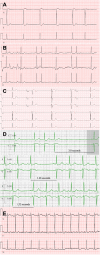Oral theophylline corrects sinus node dysfunction in acute on chronic lithium toxicity: case report and systematic review of lithium-induced Sinus node dysfunction
- PMID: 39267802
- PMCID: PMC11390494
- DOI: 10.3389/fcvm.2024.1412376
Oral theophylline corrects sinus node dysfunction in acute on chronic lithium toxicity: case report and systematic review of lithium-induced Sinus node dysfunction
Abstract
Introduction: Lithium is a well-known agent to cause systemic toxicity with its narrow therapeutic window. Toxic cardiac effects are known but seldomly reported and can manifest as sinus node dysfunction (SND) ranging from delayed conduction to sinus arrest with the potential to induce asystole. Theophylline a positive chronotropic agent has been previously used for correction of sinus node dysfunction but never been utilized for the correction of lithium-induced SND. We report the first successful use of Theophylline for rate/rhythm correction of SND in a patient presenting with acute lithium toxicity along with a review summarizing the clinical features of all published literature regarding lithium-induced SND.
Methods: Case report and systematic review of the literature are presented. Three independent scientific databases were queried for reports of lithium-induced SND. A clinical compendium was then generated detailing associated clinical data and descriptive statistics were performed.
Results: 1,117 reports were initially retrieved with full-text review yielding a cohort of 49 unique, independent studies. (61.4%) of patients presented with a supratherapeutic lithium level, 12 (21.1%) were normotherapeutic, and 11 (19.3%) were subtherapeutic. EKG findings varied but most commonly described sinus node dysfunction with a variable degree of sinoatrial block with sinus bradycardia (54.39%) and sinus arrest (29.82%) predominating. Twelve patients (21.1%) required inotrope or vasopressor support. 10 (17.5%) of patient required temporary pacing while 7 (12.3%) required permanent pacemaker implantation. In the majority of cases no significant permanent sequelae were reported as 50 (87.7%) patients recovered, 2 (3.5%) patients had persistent sinus node dysfunction, and 2 (3.5%) patients expired as a result of acute lithium toxicity.
Discussion & conclusion: In this review we report the most up-to-date and comprehensive clinical compendium of lithium-associated sinus node dysfunction along with describing a novel treatment methodology to rapidly correct lithium-induced cardiac toxicity in a patient with long-standing bipolar disorder on chronic lithium treatment. We have reviewed the available literature and provide a comprehensive summary detailing symptomatology of presentation, treatments utilized, electrocardiographic findings and patient prognoses. We have concluded that under the presumptive conditions that transient sinus node dysfunction will resolve with elimination of toxic concentrations of lithium, temporary chronotropic support provided by theophylline administration would be preferable to more invasive measures such as hemodialysis, temporary pacing, or implantation of a permanent pacemaker.
Keywords: arrythmia; hemodialysis; lithium; lithium toxicity; sick sinus syndrome; sinus bradycardia; sinus node dysfunction; temporary pacing.
© 2024 Henson, Morehead, Hagood, Wijewardane and Paydak.
Conflict of interest statement
The authors declare that the research was conducted in the absence of any commercial or financial relationships that could be construed as a potential conflict of interest.
Figures



Similar articles
-
Genetic Complexity of Sinoatrial Node Dysfunction.Front Genet. 2021 Apr 1;12:654925. doi: 10.3389/fgene.2021.654925. eCollection 2021. Front Genet. 2021. PMID: 33868385 Free PMC article. Review.
-
The duration of the sinus node depolarization on transvenous sinus node electrograms can identify sinus node dysfunction and can suggest its severity.Pacing Clin Electrophysiol. 1989 Nov;12(11):1746-56. doi: 10.1111/j.1540-8159.1989.tb01860.x. Pacing Clin Electrophysiol. 1989. PMID: 2478974
-
Biventricular pacing (cardiac resynchronization therapy): an evidence-based analysis.Ont Health Technol Assess Ser. 2005;5(13):1-60. Epub 2005 Sep 1. Ont Health Technol Assess Ser. 2005. PMID: 23074464 Free PMC article.
-
Clinical characteristics of hypervagotonic sinus node dysfunction.Korean J Intern Med. 2004 Sep;19(3):155-9. doi: 10.3904/kjim.2004.19.3.155. Korean J Intern Med. 2004. PMID: 15481606 Free PMC article.
-
Methylxanthine Derivatives in the Treatment of Sinus Node Dysfunction: A Systematic Review.Cardiol Rev. 2025 May-Jun 01;33(3):246-255. doi: 10.1097/CRD.0000000000000609. Epub 2023 Nov 1. Cardiol Rev. 2025. PMID: 37909739
References
-
- Hawks MK, Paul MLB, Malu OO. Sinus node dysfunction. Am Fam Physician. (2021) 104:179–85. PMID: . - PubMed
-
- Adán V, Crown LA. Diagnosis and treatment of sick sinus syndrome. Am Fam Physician. (2003) 67:1725–32. PMID: . - PubMed
-
- Kusumoto FM, Schoenfeld MH, Barrett C, Edgerton JR, Ellenbogen KA, Gold MR, et al. 2018 ACC/AHA/HRS guideline on the evaluation and management of patients with bradycardia and cardiac conduction delay: a report of the American College of Cardiology/American Heart Association task force on clinical practice guidelines and the heart rhythm society. Circulation. (2019) 140:e382–482. PMID: . - PubMed
-
- Semelka M, Gera J, Usman S. Sick sinus syndrome: a review. Am Fam Physician. (2013) 87:691–6. PMID: . - PubMed
Publication types
LinkOut - more resources
Full Text Sources

